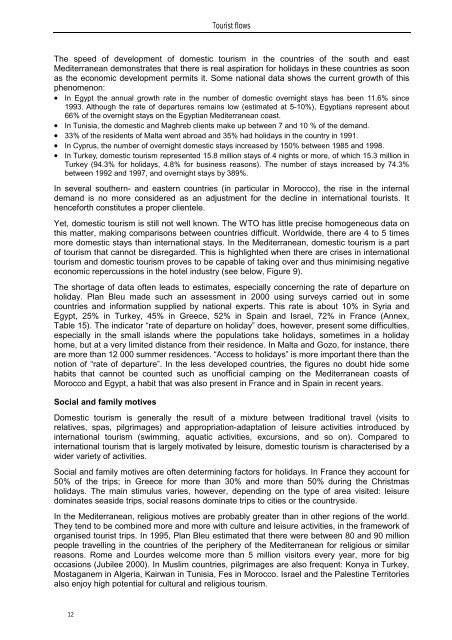dossier sur le tourisme et le développement durable
dossier sur le tourisme et le développement durable
dossier sur le tourisme et le développement durable
You also want an ePaper? Increase the reach of your titles
YUMPU automatically turns print PDFs into web optimized ePapers that Google loves.
12<br />
Tourist flows<br />
The speed of development of domestic tourism in the countries of the south and east<br />
Mediterranean demonstrates that there is real aspiration for holidays in these countries as soon<br />
as the economic development permits it. Some national data shows the current growth of this<br />
phenomenon:<br />
• In Egypt the annual growth rate in the number of domestic overnight stays has been 11.6% since<br />
1993. Although the rate of departures remains low (estimated at 5-10%), Egyptians represent about<br />
66% of the overnight stays on the Egyptian Mediterranean coast.<br />
• In Tunisia, the domestic and Maghreb clients make up b<strong>et</strong>ween 7 and 10 % of the demand.<br />
• 33% of the residents of Malta went abroad and 35% had holidays in the country in 1991.<br />
• In Cyprus, the number of overnight domestic stays increased by 150% b<strong>et</strong>ween 1985 and 1998.<br />
• In Turkey, domestic tourism represented 15.8 million stays of 4 nights or more, of which 15.3 million in<br />
Turkey (94.3% for holidays, 4.8% for business reasons). The number of stays increased by 74.3%<br />
b<strong>et</strong>ween 1992 and 1997, and overnight stays by 389%.<br />
In several southern- and eastern countries (in particular in Morocco), the rise in the internal<br />
demand is no more considered as an adjustment for the decline in international tourists. It<br />
henceforth constitutes a proper cliente<strong>le</strong>.<br />
Y<strong>et</strong>, domestic tourism is still not well known. The WTO has litt<strong>le</strong> precise homogeneous data on<br />
this matter, making comparisons b<strong>et</strong>ween countries difficult. Worldwide, there are 4 to 5 times<br />
more domestic stays than international stays. In the Mediterranean, domestic tourism is a part<br />
of tourism that cannot be disregarded. This is highlighted when there are crises in international<br />
tourism and domestic tourism proves to be capab<strong>le</strong> of taking over and thus minimising negative<br />
economic repercussions in the hotel industry (see below, Figure 9).<br />
The shortage of data often <strong>le</strong>ads to estimates, especially concerning the rate of departure on<br />
holiday. Plan B<strong>le</strong>u made such an assessment in 2000 using <strong>sur</strong>veys carried out in some<br />
countries and information supplied by national experts. This rate is about 10% in Syria and<br />
Egypt, 25% in Turkey, 45% in Greece, 52% in Spain and Israel, 72% in France (Annex,<br />
Tab<strong>le</strong> 15). The indicator “rate of departure on holiday” does, however, present some difficulties,<br />
especially in the small islands where the populations take holidays, som<strong>et</strong>imes in a holiday<br />
home, but at a very limited distance from their residence. In Malta and Gozo, for instance, there<br />
are more than 12 000 summer residences. “Access to holidays” is more important there than the<br />
notion of “rate of departure”. In the <strong>le</strong>ss developed countries, the figures no doubt hide some<br />
habits that cannot be counted such as unofficial camping on the Mediterranean coasts of<br />
Morocco and Egypt, a habit that was also present in France and in Spain in recent years.<br />
Social and family motives<br />
Domestic tourism is generally the result of a mixture b<strong>et</strong>ween traditional travel (visits to<br />
relatives, spas, pilgrimages) and appropriation-adaptation of <strong>le</strong>i<strong>sur</strong>e activities introduced by<br />
international tourism (swimming, aquatic activities, excursions, and so on). Compared to<br />
international tourism that is largely motivated by <strong>le</strong>i<strong>sur</strong>e, domestic tourism is characterised by a<br />
wider vari<strong>et</strong>y of activities.<br />
Social and family motives are often d<strong>et</strong>ermining factors for holidays. In France they account for<br />
50% of the trips; in Greece for more than 30% and more than 50% during the Christmas<br />
holidays. The main stimulus varies, however, depending on the type of area visited: <strong>le</strong>i<strong>sur</strong>e<br />
dominates seaside trips, social reasons dominate trips to cities or the countryside.<br />
In the Mediterranean, religious motives are probably greater than in other regions of the world.<br />
They tend to be combined more and more with culture and <strong>le</strong>i<strong>sur</strong>e activities, in the framework of<br />
organised tourist trips. In 1995, Plan B<strong>le</strong>u estimated that there were b<strong>et</strong>ween 80 and 90 million<br />
peop<strong>le</strong> travelling in the countries of the periphery of the Mediterranean for religious or similar<br />
reasons. Rome and Lourdes welcome more than 5 million visitors every year, more for big<br />
occasions (Jubi<strong>le</strong>e 2000). In Muslim countries, pilgrimages are also frequent: Konya in Turkey,<br />
Mostaganem in Algeria, Kairwan in Tunisia, Fes in Morocco. Israel and the Pa<strong>le</strong>stine Territories<br />
also enjoy high potential for cultural and religious tourism.
















